NHL teams typically improve in two ways: through the draft and development of young players or trading for or acquiring through free agency experienced players who fill specific needs. The Columbus Blue Jackets are in a good position to promote from within and perhaps trade for scoring. The team’s depth in goal and on defense is remarkable enough that some extra parts might be traded for players or draft picks. There are a couple of shining lights among the young forward crops, but the club isn’t nearly as deep at forward as it is elsewhere.
Depth in one area can be a double-edged sword. Having capable players available is critical if the injury bug bites hard and teams need to call up replacements from the AHL. However, when NHL general managers know that a team is overstocked, they may not offer full value for players who are on the trading block.
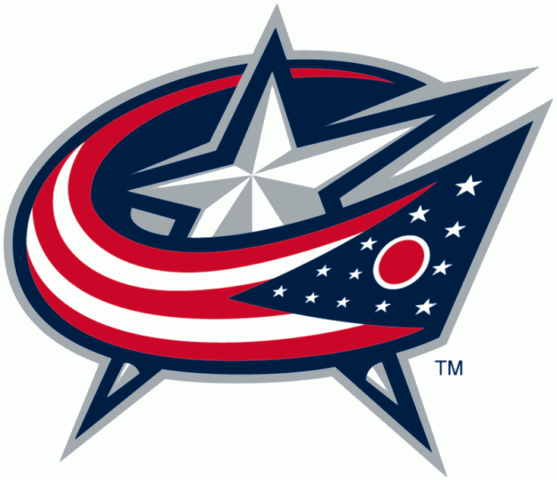
Having too many players at one position in development, a so-called logjam, can also create problems. What can they do with players who have maxed out their development in the minors, but can’t earn a roster spot on the big club? What happens when they have many players who fall into that category? NHL-ready assets stuck in the AHL are great trade bait – and can be more valuable on the market than draft picks.
The 2020-21 Salary Cap and Free Agency
The 2020-21 salary cap was projected to rise from $81.5 million to $84 million, however, The Pause due to the coronavirus pandemic put a dent in hockey-related revenue. Therefore, the salary cap for the 2020-2021 season is likely to remain steady rather than rise.
Related: How Much Do Players Get Paid in the Playoffs?
(The term “salary cap” never appears in the Collective Bargaining Agreement between the NHL and the Players’ Association. According to Article 50 of the CBA, there is a “Team Payroll Range,” which specifies the minimum amount of player payroll as well as the maximum amount a team can have in the budget at any one time.)
The Blue Jackets have already agreed to a contract with KHL star Mikhail Grigorenko, whose first go in the NHL was unsuccessful for a 1st-round pick (#12 overall in 2012 by the Buffalo Sabres). In five seasons with two clubs, he scored only 22 goals and 64 points. His contract is reportedly worth $1.2 million for one year and should be approved by the league’s Central Registry office on July 1.
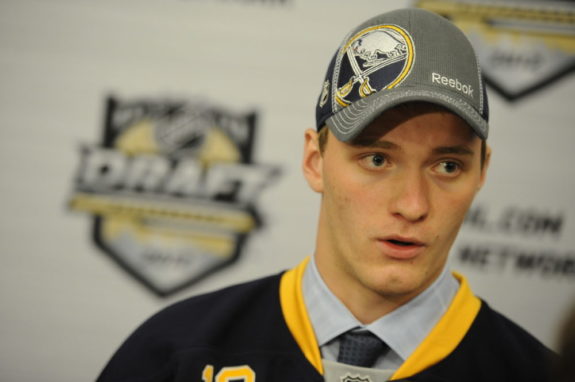
Many key Blue Jackets players are restricted free agents (RFA) at the end of the 2020-21 season, including top center Pierre-Luc Dubois and bruising winger Josh Anderson, as well as young defensemen Gabriel Carlsson and Vladislav Garikov. Minor league goalie Matiss Kivlenieks will also need a new contract.
It’s unfortunate, but some salary-cap relief may be sneaking up on the Blue Jackets. Heart-and-soul forward Brandon Dubinsky’s wrist injury may prevent him from returning to hockey. Dubinsky carries a cap hit of $5.85 million this year and next before he becomes an unrestricted free agent (UFA) after the 2021-22 season. There’s also a rather vague suggestion that oft-injured defenseman Ryan Murray might retire at the ripe age of 26. Murray’s cap hit is $4.6 million this year and next, also followed by free agency. That’s over $10 million of an $81.5 million budget.
Other important Blue Jackets who are scheduled to become UFAs in 2022 include captain Nick Foligno (cap hit $5.5 million) and solid d-man David Savard ($4.25 million). After next season, UFAs might include forwards Riley Nash ($2.75 million) and Stefan Matteau ($725,000) and Norris-worthy defenseman Seth Jones ($5.4 million) is only a year behind.
In 2020-21, not counting new contracts for Dubois, versatile forward Devin Shore (current cap hit $2.3 million), and defensemen Carlsson and Gavrikov, Columbus has over $75 million committed to roster players. If the cap does not increase, that leaves less than $7 million for the team’s RFAs, and Dubois might eat up all that cap room.
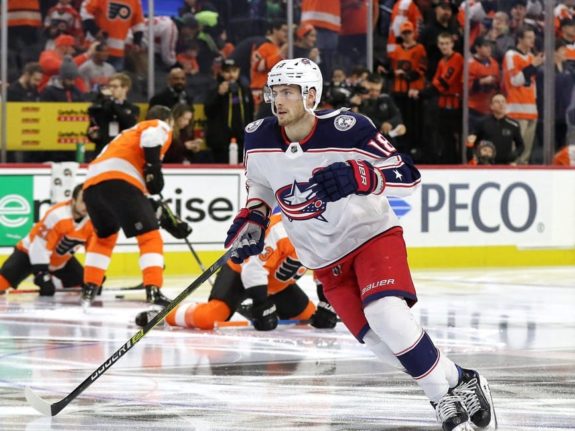
As far as the 2020 class of free agents are concerned, the players of greatest interest to the Blue Jackets (Mikko Rantanen and Ryan Nugent-Hopkins, for example) are unlikely to change teams and their contract demands would break Columbus’ bank.
To Trade or to Draft?
The pundits say you can never have too many draft picks. The Blue Jackets seem to be proving that you don’t always need lots of picks. The 2019-20 injury-filled season showed the depth of the team’s prospect pool, even after trading away top picks in recent years. This season, as one player headed to the trainer’s room, another magically appeared from the press box, the AHL – or even the OHL. The team defied expectations and was in a playoff position at the time of the NHL hiatus.
Related: NHL’s 5 Best Agitators of the Decade
General manager Jarmo Kekalainen took a lot of heat for hanging onto top-level trade deadline assets at the end of the 2018-19 season to provide the club’s long-suffering fans with playoff success. Yes, he didn’t trade those players, and yes, they left as free agents, but for the first time in Blue Jackets history, the team advanced past the first round of the playoffs. They did so in fine style, sweeping the Tampa Bay Lightning, a team that had just tied the record for wins in a regular season.

Kekalainen and his team entered the 2019 NHL Entry Draft with only a pair of draft picks, one in the 3rd round and another in the 7th. He swapped that 3rd-rounder for a pair of 4th-rounders and left Vancouver with three prospects. (Columbus has five picks in the 2020 Draft, after trading their 2nd– and 3rd-round picks.)
Defenseman Eric Hjorth (picked #104) and centers Dmitri Voronkov (#114) and Tyler Angle (#212) have the potential to be late-round picks. However, this point, nobody is confusing them with top picks Jack Hughes, Kaapo Kakko, and Kirby Dach, who combined for 191 NHL games this season (so far).
Remember that the 2019-20 Blue Jackets were expected to fall flat on their face shields after so much top-end talent left as free agents. Two-time Vezina-winning goalie Sergei Bobrovsky, All-Star winger Artemi Panarin, two-way center Matt Duchene, and hometown boy (former Ohio State player) Ryan Dzingel hit the road for greener pastures. Even rarely-used defenseman Adam McQuaid and insurance goalie Kevin Kincaid weren’t re-signed last summer.
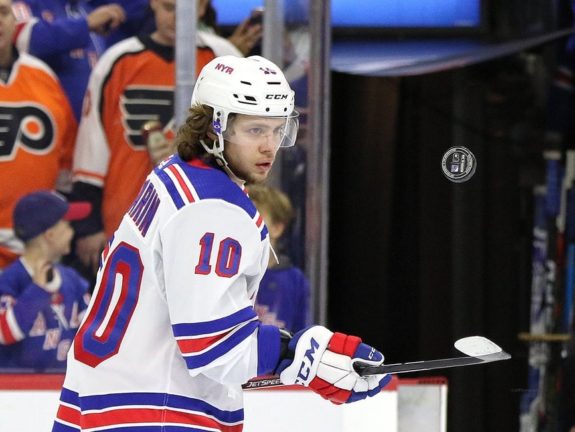
It’s often said that goaltending is the cornerstone of a championship team. A versatile defense in front of those goalies is the next piece. Of course, you won’t win a Stanley Cup without putting a few pucks in the net, so a good team needs forwards as well. Let’s see how today’s Blue Jackets stack up.
Blue Jackets Goaltending
After Bobrovsky’s departure, the Jackets’ goalie situation was expected to be in shambles. Joonas Korpisalo had served as backup for four seasons, averaging 22.5 games per season, with a goals-against average ranging from a miserable 3.32 to an almost bearable 2.60. In those four years, his best save percentage was .920, but the two seasons before 2019-20 both produced SV% of .897. Ouch! Without a move over the summer, Korpisalo was the presumptive starter going into 2019-20, despite coming off two pretty bad seasons.
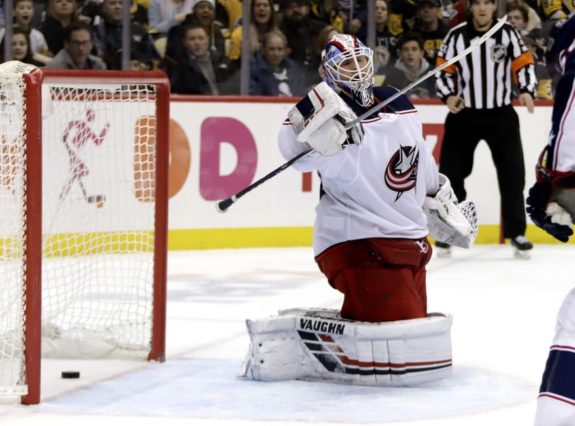
Backing him up? A young Latvian named Elvis. Thank goodness for the interesting first name – it was months before announcers settled on how to pronounce Merzlikins. (“muhrz-LIH-kihnz,” with two short-i’s.) He’d been tearing up the Swiss league, but my colleague Eugene Helfrick doesn’t consider it to be among the 10 best leagues in the world. How would Merzlikins adjust to the smaller North American ice surface? The angles change, the passing lanes change, the sweet spots for shooters are a little different. and let’s not forget about the trapezoid. (At least the nets still have the same dimensions.)
Related: The First Jeff Carter Trade Revisited
The season started very well for Korpisalo. Well enough, that he earned an All-Star selection. (He did not play in the game, however, due to injury.) Merzlikins had the opposite experience in 2019. That adjustment period wasn’t as smooth as many had hoped. He gave up seven goals in his first start and he lost all 10 of his first appearances (0-5-5).
On Dec. 29, Korpisalo played through regulation time but was injured in overtime – overtime that Columbus coach John Tortorella said should never have happened. Merzlikins took over in goal and ended up with the loss in a game in which his GAA was 0.00 (losing in a shootout).

The All-Star starting goalie was out for weeks with a knee injury and the backup who couldn’t buy a win steps in. Magic happened. Starting with the traditional New Year’s Eve game at Nationwide Arena, Merzlikins played lights-out, finishing the remainder of the season (so far) with a 14-5-4 record, including five shutouts in eight games.
The team in front of him outscored their opponents by more than two goals (including empty-netters) in only 4 of 23 games. Seven were decided in overtime or a shootout (three wins, four losses). Korpisalo’s record after returning from injury was 2-2-1, with a win and a loss in overtime.
At the time of the NHL Pause, the Blue Jackets’ goaltending was looking pretty good. Good enough, that both Korpisalo and Merzlikins (both 26 years old) were signed to two-year extensions in April.
My colleagues Ryan Szporer and Mark Scheig have differing opinions (to put it mildly) about those extensions. Ryan suggested that signing Merzlikins for only two years (at an average annual value of $4 million) might be a missed opportunity. Mark, on the other hand, used the word “luxurious” to describe the Blue Jackets’ goaltending situation. (Korpisalo was re-signed first, and his two-year extension averages $2.8 million.) The next four years combined for the two goalies ($13.6 million) is not much more than Bobrovsky’s contract with the Florida Panthers next season ($12 million actual cash, $10 million cap hit).
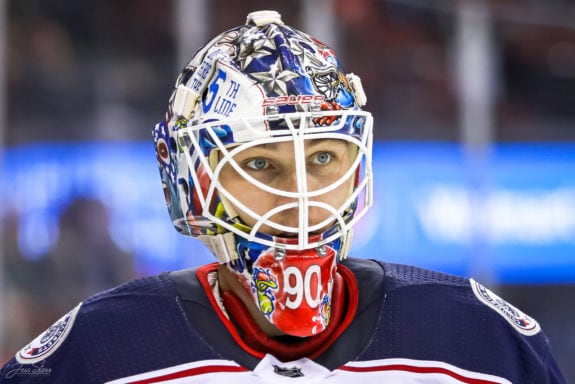
But wait, there’s more! Not only do you get a pair of starting goalies (call them 1A and 1B, but don’t tell them who is who), the Blue Jackets goaltender prospects include 23-year-olds Veini Vehvillainen and Matiss Kivlenieks with the AHL affiliate Cleveland Monsters, as well as 21-year-old Daniil Tarasov (who played this year in the Finnish Elite League). On the team’s reserve list is 2016 draftee (6th round) NCAA goalie Peter Thome (pronounced “TOHM-ay”), who starred at the University of North Dakota, who ended the season with a 1.37 GAA and a SV% of .935. He’ll be back at North Dakota for his senior year.
Blue Jackets Defensemen
Of the 10 defensemen who played for the Blue Jackets in 2019-20, seven are on one-way contracts. That should make it an easy decision about who stays with the big club and who heads to Cleveland, but that’s just the wallet talking not the play on the ice. Columbus has 10 legitimate NHL-quality defensemen on their roster and perhaps a couple in the pipeline.
All 10 of the top d-men should be ready to play when the NHL resumes, including Jones. None of them is over 30 years old, although Savard is 29 and often-injured Murray has a lot of miles on his 26-year-old bones. However, the average age of their top 10 is just over 24. (In salary, the top eight Blue Jackets defensemen combined earn less than the top three defensemen for the San Jose Sharks.)
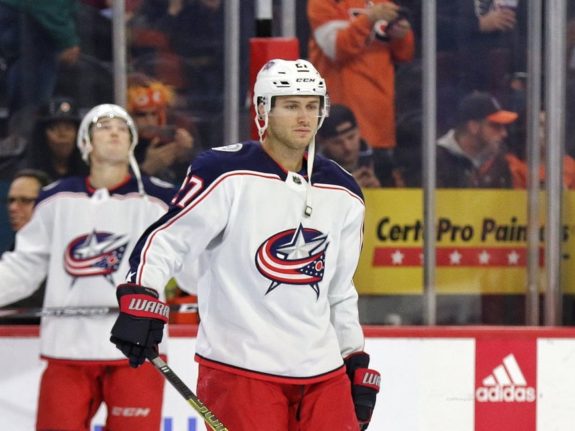
Nine additional defensemen are on the Monsters roster, not including the pair that have played for Columbus this year. That’s 19 defensemen between the NHL and AHL. Considering that only six typically dress per team on game days, a lot of players are watching instead of banging bodies.
One further note: While the 2020 Entry Draft order of picks is still up in the air, Columbus will likely draft somewhere in the middle of the 1st round. According to the NHL’s Central Scouting Bureau’s Prospect Report, one-third of the top North American and European skaters are defensemen. That makes it a very good year for drafting defense.
If the Blue Jackets use their top pick on yet another defenseman, they might get a gem or they could weaken the team’s trade prospects. If other GMs recognize the additional defensive depth in Columbus’s pipeline, Kekalainen’s trade options could be restricted to some degree. There can be “too much of a good thing” when it comes to negotiating a deal.
Blue Jackets Forwards
A couple of forwards who were expected to take a step forward and become regulars on the tops lines in 2019-20 ended the season on IR, but are expected back when play resumes. Alexandre Texier suffered a fracture in his spine during the same game that put Korpisalo on the shelf. (Texier is due for a big raise before he becomes an RFA in 2022) Anderson’s shoulder injury, which occurred a couple of weeks before Texier and Korpisalo went down, eventually required surgery. Veteran Dubinsky has been out with a wrist injury since the preseason and may not return when skates again hit the ice.

The Blue Jackets’ forward lines are not likely to be confused with that of the Pittsburgh Penguins, nor do they have the tantalizing talent of certain Toronto Maple Leafs and Edmonton Oilers skaters. However, they have a hard-nosed, physical style that can produce results. (Ask the Lightning), and despite the injuries, they are reasonably deep.
Related: Resetting the Blue Jackets’ Injured List
The loss of Panarin, Duchene, and Dzingel was a blow to the team’s goal-scoring, and several forwards didn’t perform at the same pace as last season. Cam Atkinson dropped from .513 goals-per-game to .273. Dubois fell from .329 to .257. Anderson’s injuries didn’t help, but don’t explain dropping from 27 goals in 82 games to a single goal in 26 games.
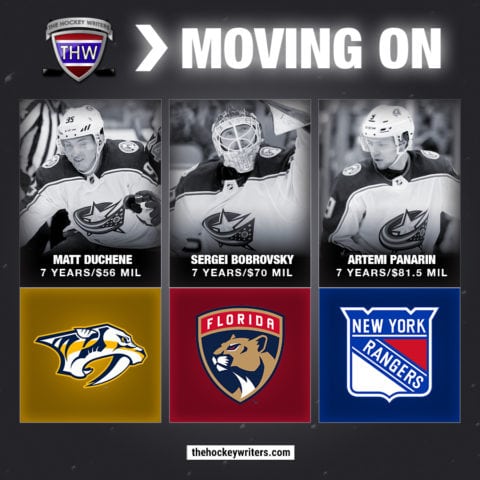
On the flip side, Oliver Bjorkstrand jumped from 23 goals in 77 games (.299 goals-per-game) to 21 in 49 games (.429). Zach Werenski set a new record for goals by a Blue Jackets defenseman with 20 (leading the league for defensemen goals at The Pause), and he did it in only 63 games. Gustav Nyquist who was signed to provide some offense, chipped in with 15 goals in 70 games. (He and Dubois were the only players to appear in all 70 games.)
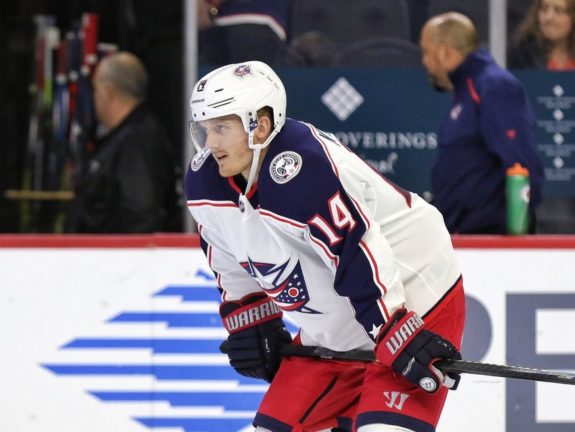
The Blue Jackets are hoping that Grigorenko will provide some additional scoring when he returns to the NHL. He’s spent the past three years in the KHL, helping CSKA Moscow to the league championship last year, scoring 21 points in 20 playoff games.
The Blue Jackets have only 19 forwards on their roster, including the injured Texier, Anderson, and Dubinsky. Non-roster and prospect forwards total 15, including tantalizing young talents Liam Foudy and Trey Fix-Wolansky.
Columbus Going Forward
When I look at the state of the Blue Jackets, I see a team that’s not only strong in goal but is likely set for the next decade or more. By the time Tarasov and Thome are ready to battle with Vehvillainen and Kivlenieks for net time, they may still be waiting behind Korpisalo and Merzlikins.
Related: Blue Jackets’ Signings Show Early Glimpse of Next Season
The defense has an overabundance of NHL-ready players (many best suited for the second pair). Jones, who will almost certainly be in the Norris conversation next season, and the newly-minted goal machine Werenski are a top pair that should make general managers drool with envy. Consider them untouchable. Also unlikely to be traded is Ryan Murray.
Between his salary and injury history, consider him to be closer to a buyout candidate than trade bait, but I expect him to stick around through the last year of his contract. Senior citizen (at 29) Savard also carries a hefty salary (over $4 million), but only has one year left on his contract. That leaves some young and talented d-men itching for ice time behind Jones-Werenski.
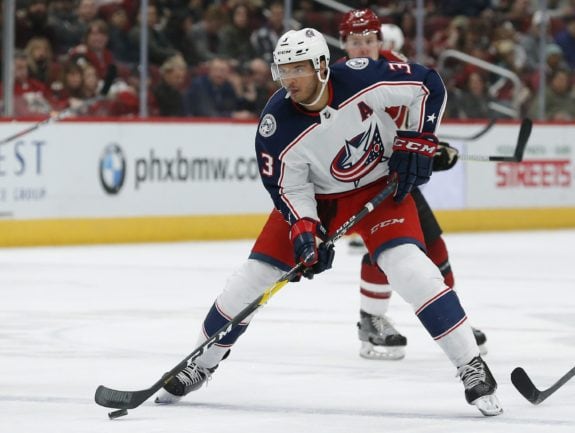
If Kekalainen wants to “go forward,” he has plenty of assets in goal and on defense with which to make deals for scoring upfront. Unfortunately, that danged salary cap could really handicap him. Trading young talent (usually on low-cost contracts) for proven performers (usually on more expensive contracts) creates more cap pressure. Trading salary-for-salary (think Savard for a secondary scoring forward perhaps) opens room for young players to move up while keeping cap pressure under control.
Until the salary cap goes up, Kekalainen is restricted in what he can do to improve the team’s scoring. He has some wonderful trade bait but may need to hold onto those assets for another year before he can get full value for them. Of course, he could dangle them for additional picks in the 2020 Entry Draft (and/or a future draft). While that might break the logjam, it might set the stage for another down the road. Ah, the joys of having a deep pipeline!
Statistics are from CapFriendly.com and HockeyDB.com and are current as of the date of publication.